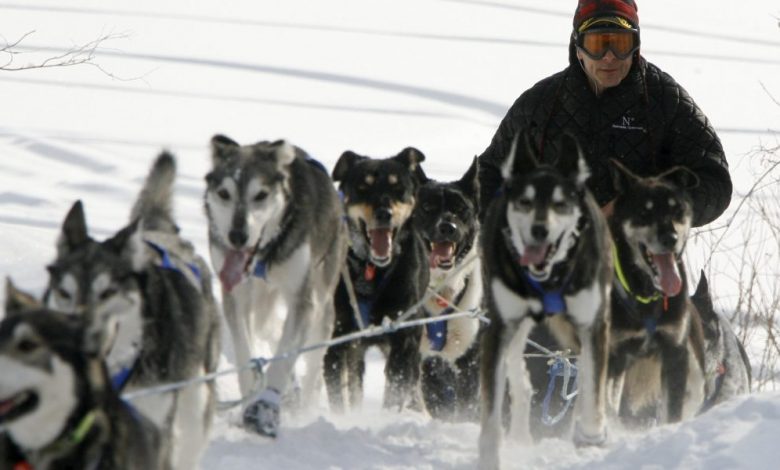Inflation means the smallest pool of Iditarod competitors ever

The second half-century for the world’s most famous sled dog race got off to a rocky start.
Just 33 mushers will take part in Saturday’s ceremonial start of the Iditarod Trail Sled Dog Race, the smallest field ever to take its canine teams nearly 1,000 miles (1,609 kilometers) through the unforgiving Alaskan wilderness. This year’s line-up is even smaller than the 34 mushers who lined up for the very first race in 1973.
The small pool of mushers is raising concerns about the future of an iconic race that has been hit by the pandemic, climate change, inflation and the loss of financially strong sponsors, as several notable champion mushers retire with few left to take over your place.
The largest field of all time in 2008 was 96 mushers; The average number of mushers who started the race over the last 50 years was 63.
“It’s a bit scary in that way,” said four-time winner Martin Buser, 64, who retired after his 39th race last year. “Hopefully it’s not a state of affairs and … it’s just a temporary hiatus.”
The Iditarod is the world’s most prestigious sled dog race, taking participants in frigid temperatures across two mountain ranges, the frozen Yukon River and the treacherous ice of the Bering Sea before ending in the old gold rush town of Nome. The approximately 10-day event begins on Saturday with a “ceremonial start” in Anchorage, followed by the competition start on Sunday in Willow, about 113 kilometers north.
And while the world-famous race boasts the highest purse of any sled dog competition, the winner only collects about $50,000 before taxes — a payout that’s less attractive given inflation and the ongoing reverberations of the pandemic.
Many mushers supplement their income by offering unique Alaskan experiences to cruise passengers, but in recent years the pandemic has resulted in fewer summer visitors spending money on a glacier dog sled ride.
“There are a lot of kennels and a lot of mushers that are relying on that to keep going,” said Aaron Burmeister, a Nome native who is sitting out this year’s race to spend more family time. Burmeister, who works in the construction industry, has achieved eight top 10 rankings over the past decade.
“The opportunity to race the Iditarod and the expense of putting together a racing team became more than they could bear to support themselves,” he said of Musher.
Inflation has also taken its toll, with several mushers saying they would like to see higher prize money to attract younger competitors.
Defending champion Brent Sass, who supplements his income as a wilderness guide, is not surprised that some mushers are taking a break to build bank accounts.
Sass, who has 58 dogs, orders 500 bags of premium dog food annually. Each bag was $55 a few years ago, but that’s swelled to $85 per bag — or about $42,500 a year overall. That’s how much money Sass pocketed in his Iditarod win last year.
“You have to be absolutely willing to run Iditarod and have enough money in the bank to do it,” said Sass, who lives in Eureka, about a four-hour drive north of Fairbanks.
With other racing expenses, Buser said the Iditarod race now can mean spending $250,000 to win a $40,000 championship.
The race itself has suffered from increased inflation, said Rob Urbach, CEO of Iditarod. Supply costs have increased about 30%, he said, and last year it cost nearly $30,000 to haul specially certified straw from the lower 48 for dogs to sleep on at race checkpoints.
The Iditarod also continues to be pursued by People for the Ethical Treatment of Animals, who have targeted the race’s biggest sponsors. Over the past decade, Alaska Airlines, ExxonMobil, Coca-Cola and Wells Fargo have all stopped sponsoring races after being targeted by PETA.
PETA ran full-page newspaper ads in Anchorage and Fairbanks in February featuring a husky — the predominant sled dog breed — with the headline “We don’t want to go to the Iditarod. We just want the Iditarod to go.”
But Urbach said the financial health of the race is good and the payouts should be slightly higher this year. The top 20 finishers receive payouts on a sliding scale, and every other finisher receives $1,049, reflecting the race’s advertised mileage, although actual mileage is lower.
Noting that they pay “the healthiest prize money” among sled dog competitions, Urbach called the PETA campaign “pretty offensive, I think, to most Alaskans.”
There are also concerns about the future of the race because of climate change.
The warming climate forced organizers to move the start line 290 miles (467 kilometers) north of Willow to Fairbanks in 2003, 2015 and 2017 due to lack of snow in the Alaska Range. Bad winter conditions and urban growth also caused the Iditarod to officially move the launch from Wasilla about 30 miles (48 kilometers) north to Willow in 2008, although Wasilla last hosted the launch in 2002.
Shifting the start of the race north is likely to become more common as global warming progresses, said Rick Thoman, a climate specialist at the International Arctic Research Center at the University of Alaska Fairbanks. The ice on Alaska’s west coast could also be thinning and becoming more dangerous, he said.
“It doesn’t have to be that waves break on the beach,” Thoman said of the effects of the ice melt. “It just has to be where the ice isn’t stable.”
As the challenges pile up, this year several seasoned, multi-championship mushers have stepped down after decades of braving the cold and windy conditions to train for the Iditarod in mid-winter in Alaska. They find that, this year at least, few are ready to take their place.
“I just got back from Cancun to watch the Grateful Dead play on the beaches of Mexico,” said four-time champion Jeff King, who is now 67 at 66, so I don’t feel like I’m stepping on anyone .”
Five-time champion Dallas Seavey said last year’s race was the last time he spent time with his daughter, at least for a while. Other past non-racing champions include Dallas’ father, three-time champion Mitch Seavey, and Joar Leifseth Ulsom and Thomas Waerner, who each have a title.
Waerner said sponsors are holding back and that paying $60,000 to bring his team from Norway to Alaska is too expensive.
Lance Mackey, another four-time champion, died of cancer last year. He is the honorary musher for this year’s race, and his children, Atigun and Lozen, will ride in the first sled to leave the ceremonial start line in Anchorage and during Sunday’s competition start.
That leaves two former winners in this year’s field, Sass and Pete Kaiser.
Sass said he’s confident the Iditarod will weather this downturn.
“If we can just keep the train rolling forward, I think it’ll come back, and hopefully our world can get things under control and maybe things get a little cheaper,” Sass said. “I think that will help push our numbers back up.”



